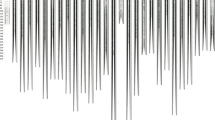Abstract
This study was conducted to determine optimum selection strategies for economically important traits in mulberry silkworm Bombyx mori. A total of 450 cocoons (225 males, 225 females) in each of two strains, 107 (Japanese) and 110 (Chinese), were used to establish base populations. Studied traits were cocoon weight (CW), cocoon shell weight (CSW) and cocoon shell percentage (CSP), which were recorded individually. Six selection strategies including random selection (control), subjective selection based on cocoon appearance, selection based on CW, selection based on CSW, selection based on a selection index using phenotypic values and selection based on a selection index using estimated breeding values (EBVs) for CW, CSW and CSP, were used for three consecutive generations. Breeding values were estimated using an animal model based on derivative-free algorithm of restricted maximum likelihood. In each strategy, a total of 12 males and 12 females were selected and randomly mated to constitute 12 full-sib families in next generation. In each family a total of 50 individuals (25 males and 25 females) were randomly recorded for CW, CSW and CSP. Results showed higher CW and CSW in strain 110 and higher CSP in 107. Selection index based on EBVs resulted in higher values of CSW and CSP, compared to the control group. Selection strategies had different effects on different generations. However, EBVs for all traits significantly increased in total population. It seems that selection based on selection indices, especially using breeding values, is more efficient to improve all economically important traits.


Similar content being viewed by others
References
Avendano SJ, Woolliams JA, Villanueva B (2004) Mendelian sampling terms as a selective advantage in optimum breeding schemes with restrictions on the rate of inbreeding. Genet Res 83:55–64
Collard BCY, Jahufer MZZ, Brouwer JB, Pang ECK (2005) An introduction to markers, quantitative trait loci (QTL) mapping and marker-assisted selection for crop improvement: The basic concepts. Euphytica 142:169–196
Darmand S, Lavvaf A, Seidavi AR, Eila N, Nematollahian S, Farahvash T (2011) Estimation of genetic parameters in three commercial silk-worm lines of Iran. Afr J Biotechnol 10:13324–13330
Harris PL (1970) Breeding for efficiency in livestock production: defining the economic objectives. J Anim Sci 30:860–865
Hosseini Moghaddam SH, Emam Jomeh Kashan N, Mirhosseini SZ, Gholami MR (2005) Genetic improvement of some traits in four strains of silkworm, Bombyx mori L. Int J Indust Entemol 10:95–99
Meyer K (1997) Programs to estimate variance components by restricted maximum likelihood using a derivative-free algorithm. In: User Notes. Animal Genetics and Breeding Unit, Univ., New England, Armidable
Mirhosseini SZ, Ghanipoor M, Shadparvar A, Etebari K (2005) Selection indices for cocoon traits in six commercial silkworm (Bombyx mori L.) lines. Philipp Agric Sci 88:328–336
Mirhosseini SZ, Nematollahian S, Ghanipoor M, Seidavi AR (2010) Comparison of phenotypic and genetic performance of local silkworm groups and two commercial lines. Biol Res 43:411–416
Neshagaran Hemmatabadi R, Seidavi AR, Gharahveysi S (2016) A review on correlation, heritability and selection in silkworm breeding. J Appl Anim Res 44:9–23
SAS Institute (2013) Users Guide, Version 9.4: Statistics. SAS Institute, Cary, NC.
Seidavi AR (2010a) Estimation of genetic parameters and selection effect on genetic and phenotype trends in silkworm commercial pure line. J Anim Vet Adv 5:1–12
Seidavi AR (2010b) Investigation on effect of individual selection based on cocoon weight on additive genetic value and selection index value in six commercial silkworm pure lines. World J Zool 5:7–14
Seidavi AR (2010c) Relationship between season and efficiency of individual selection in six peanut and oval lines of silkworm. J Eng Technol 2:211–214
Seidavi AR, Goldsmith MR (2014) Comparison of phenotypic value changes in pure lines of Bombyx mori (Lepidoptera: Bombycidae) during consecutive generations following initial selection on cocoon weight. J Insect Sci 14(1):–6
Zanatta DB, Bravo JP, Barbosa JF, Munhoz RE, Fernandez MA (2009) Evaluation of economically important traits from sixteen parental strains of the silkworm Bombyx mori L (Lepidoptera: Bombycidae). Neotrop Entomol 38:327–331
Zhan S, Huang J, Guo Q, Zhao Y, Li W, Miao X, Goldsmith MR, Li M, Huang Y (2009) An integrated genetic linkage map for silkworms with three parental combinations and its application to the mapping of single genes and QTL. BMC Genomics 10:389. https://doi.org/10.1186/1471-2164-10-389
Zhao Y, Chen K, He S (2007) Key principles for breeding spring-and-autumn using silkworm varieties: from our experience of breeding 873×874. Casp J Environ Sci 5:57–61
Acknowledgements
The authors are thankful to the personnel of the Iran Silkworm Research Centre for their kindly cooperation.
Author information
Authors and Affiliations
Corresponding author
Additional information
Publisher’s note
Springer Nature remains neutral with regard to jurisdictional claims in published maps and institutional affiliations.
Rights and permissions
About this article
Cite this article
Zamani, P., Ghanipoor, M., Mirhosseini, SZ. et al. Comparison of different selection strategies for mulberry silkworm, Bombyx mori. Int J Trop Insect Sci 39, 139–145 (2019). https://doi.org/10.1007/s42690-019-00015-8
Accepted:
Published:
Issue Date:
DOI: https://doi.org/10.1007/s42690-019-00015-8




